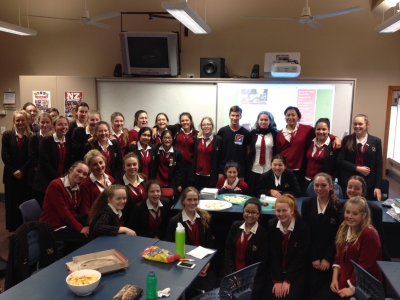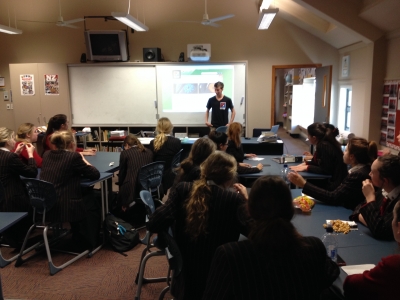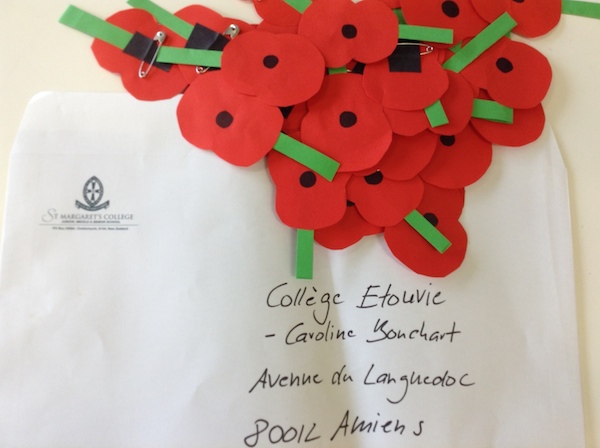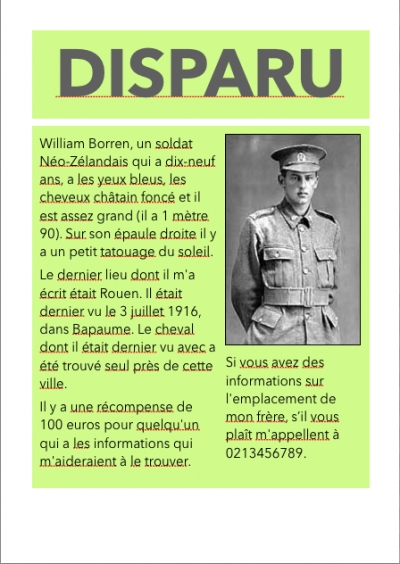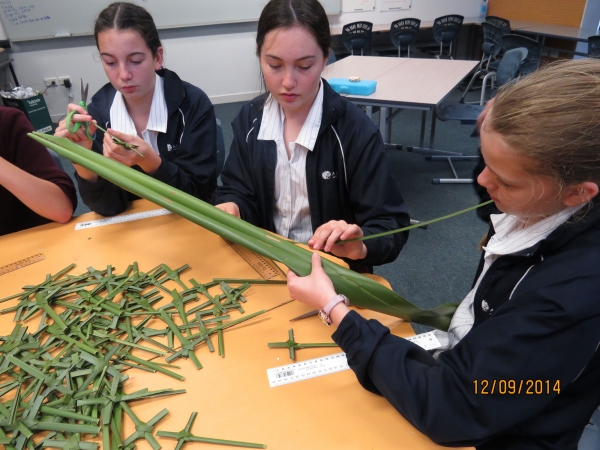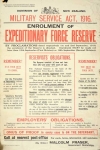The first few days in France
We left NZ on the 25th of September for a mammoth 40 hour journey. We stopped in Melbourne, then on to Dubai and finally to Paris. The flight was longer as we had to avoid the usual route over Syria and Iraq. Instead the plane flew across the mountains of Afghanistan giving the students a marvellous view. On arriving in Paris we had 2 hours until the train left for Bordeaux. Then we finally arrived and could sleep in a bed. At breakfast the students thought they had died and gone to...
Josh Hansen's visit
Visit from Josh Hansen - Young Ambassador for Shared Histories
Josh Hansen, one of the Young Ambassadors for Shared Histories, visited Baradene College and talked about his project and his trip to France and Belgium.
On échange en virtuel, mais on aime le courrier "escargot"!
Just in time before the end of Term 3, the gorgeous year 8 French girls at St Margaret's got busy crafting poppies for their friends in Amiens. And as you can see in the picture, I put the envelope in the wrong slot (also: spot the typos!), but I completely trust the NZ post services, and hope the poppies will arrive on time for Armistice Day. Luckily, there is still some time before November!
Shared Histories meets NCEA assessment: A successful first year!
This year I tied the project to some of my internal assessment at level 1, and chose to craft a 1.5 Writing Portfolio task around Shared Histories. In cooperation with our partner school in Amiens, my year 11 class set up an exchange of letters and other texts that the students from both countries posted on our wiki (one of the last texts written is attached to this post: a poster).
While the...
Making Dolores Cross
The students at AJHS have also been involved in the Dolores Cross Project.
This is a project started by Dolores Ho, Chief Archivist at the Waiouru Army Museum.
Her vision is to have every NZ grave in foreign cemeteries visited and a Dolores Cross placed there. The grave is then photographed. The Dolores Cross is a harakeke (flax) cross with an ANZAC poppy.
Our students feel privileged to be part of this and see this as a service that they can provide as they are lucky to be traveling to...
NZ's Government Policies Towards Pacifists during World War One
Our Research Report - By Sinead Burns, Lara Sell, Sofia Schollum
For our Blog post we are reporting on our research focus - What were the government’s policies (New Zealand) towards pacifists in World War One?
During World War 1 and many other wars in general, there has been a wide expectation that all men had an obligation to fight.
Introduced in 1912, the Defence Amendment Act stated that appropriate punishment would follow any objection to conscription. The punishment would include...
Conscription during War
We have researched who objected to conscription and refused to fight in the First World War. We came up with a number of key ideas when researching our topic about what type of people refused to fight during the First World War.
Conscription, which is the compulsory enlistment of people in the military forces, was not popular with all New Zealand people.
In 1915, 78 000 men stated that they were not willing to volunteer in New Zealand. Campaigns only managed to enlist 30% of those...The Fourteen Objectors Sent to France
The Fourteen sent to France - Research by Stephanie Upston and group
We have begun to research who the fourteen men were and how were these conscientious objectors were treated in New Zealand and France?
There were 14 men who were not prepared to fight these men include:
-Fred Adin
-Garth Ballantyne
-Alexander, John and Archibald Baxter
-Mark Briggs
-David Gray
-Thomas Harland
-Lawrence Kirwin
-William Little
-Daniel Magurie
-Henry Patton
-Lewis Penwright
-Albert Sanderson
...
More...
Background to Anti-Militarism in New Zealand
This is research that we have started on Anti-Militarism in New Zealand at the time of the First World War. By Rose Stoddart, Claudia Wollaston, Indiya Dawson-Myers, Bella Hannah, Rewa Kendall.
An English language translation follows the French version of our update.
Définitions:
Pacifisme: La croyance que la guerre et la violence sont injustifiables.
Privation des droits civiques: l incapacité de voter.
Le fond de l'anti-militarisme
De petits groupes de Néo-Zélandais étaient contre les...
The Treatment of Conscientious Objectors in New Zealand - Wanganui Detention Barracks
Treatment of the Objectors – Wanganui Detention Centre
The policy implemented in which the objectors were treated by was extremely harsh with victims suffering brutal acts affecting them all physically, mentally and emotionally.
The grounds of the Wanganui Detention Barracks were often nicknamed the ‘slaughter yard’ with evidence of blood splatters displayed throughout the yard. Those who refused to co-operate were pushed, pulled, kicked and...Anti-Conscription During WW1
Anti-Conscription During World War One
What actions were undertaken by those involved in the movements against conscription of men as soldiers?
Religious objectors would not serve in the Army Service Unit or Medical Corps during the war while refusing to wear uniforms for non-combatant roles. 73 conscientious objectors had been exempted for religious reasons but in Trentham Military Camp, 15 religious objectors refused to do any work or wear uniforms. They were...Fourteen Men to France - research progress
Research Progress by Annie Kane, Louise Piggin, Danielle Mitchell, Laura McRae, Rewa Kendall and Mikayla Eruera
How were the conscientious objectors treated in NZ and France?
Conscientious objectors in NZ were not treated lightly. A conscientious objector is person who for reasons of conscience objects to serving in the armed forces.
Conscientious objectors in New Zealand were first sent to prison camps or were forced into hard labour as sentences for refusing to fight or responding to...
Search
Who's Online?
The following members are online:
Latest Forum Posts
- No posts to display.
Powered by Technologywise / Design by yojodesign

